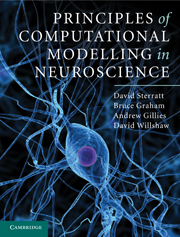Book contents
- Frontmatter
- Contents
- List of abbreviations
- Preface
- Acknowledgements
- Chapter 1 Introduction
- Chapter 2 The basis of electrical activity in the neuron
- Chapter 3 The Hodgkin–Huxley model of the action potential
- Chapter 4 Compartmental models
- Chapter 5 Models of active ion channels
- Chapter 6 Intracellular mechanisms
- Chapter 7 The synapse
- Chapter 8 Simplified models of neurons
- Chapter 9 Networks of neurons
- Chapter 10 The development of the nervous system
- Chapter 11 Farewell
- Appendix A Resources
- Appendix B Mathematical methods
- References
- Index
Chapter 9 - Networks of neurons
- Frontmatter
- Contents
- List of abbreviations
- Preface
- Acknowledgements
- Chapter 1 Introduction
- Chapter 2 The basis of electrical activity in the neuron
- Chapter 3 The Hodgkin–Huxley model of the action potential
- Chapter 4 Compartmental models
- Chapter 5 Models of active ion channels
- Chapter 6 Intracellular mechanisms
- Chapter 7 The synapse
- Chapter 8 Simplified models of neurons
- Chapter 9 Networks of neurons
- Chapter 10 The development of the nervous system
- Chapter 11 Farewell
- Appendix A Resources
- Appendix B Mathematical methods
- References
- Index
Summary
An essential component of the art of modelling is to carry out appropriate simplifications. This is particularly important when modelling networks of neurons. Generally, it is not possible to represent each neuron of the real system in the model, and so many design questions have to be asked. The principal questions concern the number of neurons in the model network, how each neuron should be modelled and how the neurons should interact. To illustrate how these questions are addressed, different types of model are described. These range from a series of network models of associative memory, in which both neurons and synapses are represented as simple binary or multistate devices, two different models of thalamocortical interactions, in which the neurons are represented either as multi-compartmental neurons or as spiking neurons, and multi-compartmental models of the basal ganglia and their use in understanding Parkinson's disease. The advantages and disadvantages of these different types of model are discussed.
In their implementation of Marr's influential theory of cerebellar cortex as a learning machine (Marr, 1969), Tyrrell and Willshaw (1992) constructed a simulation model of all the circuitry associated with a single Purkinje cell. With the limited computing resources available at the time, they did this by modelling each 3D layer of cells and connections in a 2D plane. To build the model they had to guess many parameter values about the geometry as these were not available. Their simulation results agreed broadly with the analysis carried out by Marr.
Information
- Type
- Chapter
- Information
- Principles of Computational Modelling in Neuroscience , pp. 226 - 266Publisher: Cambridge University PressPrint publication year: 2011
